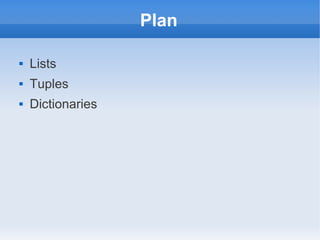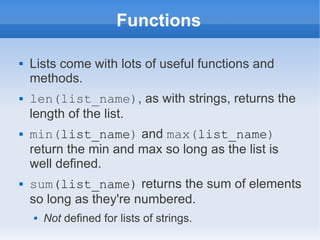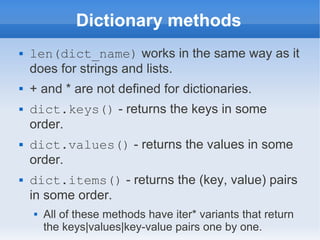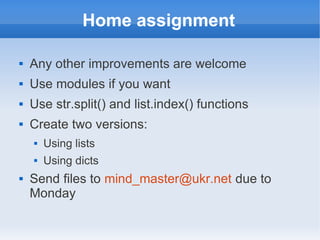Anton Kasyanov, Introduction to Python, Lecture4
- 1. Introduction to Python Lecture 4 Kasyanov Anton IASA 2011
- 2. Plan Lists Tuples Dictionaries
- 3. Lists Python has a way of grouping similar items called a list. Denoted by: list_name = [list_elt0,list_elt1, ..., list_eltn]
- 4. Lists To get to the i-th element of a list we use: list_name[i-1] We use i-1 because lists are indexed from 0. This means to refer to the elements of a 4 element list named list_name we use list_name[0], list_name[1], list_name[2], list_name[3] Lists are mutable.
- 5. Lists You can also have an empty list: []. You can index into lists from the back. list_name[-i] returns the ith element from the back. Lists are mixed: That is, the elements in a list need not be the same type, can have ints and strings. Can even have lists themselves. + and * operators are overloaded for lists
- 6. Functions Lists come with lots of useful functions and methods. len(list_name), as with strings, returns the length of the list. min(list_name) and max(list_name) return the min and max so long as the list is well defined. sum(list_name) returns the sum of elements so long as they're numbered. Not defined for lists of strings.
- 7. Methods append(value) – adds the value to the end of the list. sort() - sorts the list so long as this is well defined. (need consistent notions of > and ==) insert(index, value) – inserts the element value at the index specified. remove(value) – removes the first instance of value. count(value) – counts the number of instances of value in the list.
- 8. Looping Often we want to do a similar operation to every element of the list. Python allows us to do this using for loops. for item in list: block This is equivalent to: item = list[0] block item = list [1] block ...
- 9. Looping To do that, we use the range() function. range(i) returns an ordered list of ints ranging from 0 to i-1. range(i,j) returns an ordered list of ints ranging from i to j-1 inclusive. range(i,j,k) returns a list of ints ranging from i to j-1 with a step of at least k between ints. So range(i,k)==range(i,k,1) To modify a list element by element we use: for i in range(len(list)): list[i] = ...
- 10. Slicing Sometimes we want to perform operations on a sublist. To refer to a sublist we use list slicing. y=x[i:j] gives us a list y with the elements from i to j-1 inclusive. x[:] makes a list that contains all the elements of the original. x[i:] makes a list that contains the elements from i to the end. x[:j] makes a list that contains the elements from the beginning to j-1.
- 11. Tuples Sometimes we want our lists to be immutable. To do that we can make a tuple. tuple_name=(item0,item1,item2,...) Items are referenced by tuple_name[i] not tuple_name(i) Single element tuples must be defined with a comma to avoid ambiguity (8+3) vs. (8+3,)
- 12. Strings Strings can be considered tuples of individual characters. (since they are immutable). In particular, this means that we can use the list knowledge that we gained, an apply it to strings. Can reference individual characters by string[+/-i]. Strings are not mixed, they can only contain characters. min() and max() defined on strings, but sum() is not. You can slice strings just as you can lists.
- 13. Strings Now that we know that we can index into strings, we can look at some more string methods. find(substring): give the index of the first character in a matching the substring from the left or -1 if no such character exists. rfind(substring): same as above, but from the right. find(substring,i,j): same as find(), but looks only in string[i:j].
- 14. Nested lists Because lists are mixed, we can have lists of lists. This is useful if we want matrices, or to represent a grid or higher dimensional space. We then reference elements by list_name[i][j] if we want the jth element of the ith list. So then naturally, if we wish to loop over all the elements we need nested loops: for item in list_name: for item2 in item: block
- 15. Dictionaries In one sentence, dictionaries are (key, value) pairs. Sometimes they are called maps. Python syntax: {key0 : value0, key1 : value1, ..., keyn : valuen} Dictionaries are of type dict Since they have a type, they can be assigned to a variable. To refer to a value associated with a key in a dictionary we use dictionary_name[key]
- 16. Dictionaries Dictionaries are unsorted. Dictionary keys must be immutable, but the values can be anything. Cannot be None. Once you've created a dictionary you can add key-value pairs by assigning the value to the key. dictionary_name[key] = value Keys must be unique.
- 17. Dictionary methods len(dict_name) works in the same way as it does for strings and lists. + and * are not defined for dictionaries. dict.keys() - returns the keys in some order. dict.values() - returns the values in some order. dict.items() - returns the (key, value) pairs in some order. All of these methods have iter* variants that return the keys|values|key-value pairs one by one.
- 18. Dictionary methods dict.has_key(key) - returns True iff the dictionary has the key in it. dict.get(key) – returns the value that is paired with the key, or None if no such key exists. get(key, d) returns d rather than None if no such key exists. dict.clear() - removes all the key-value pairs from the dictionary.
- 19. Files How to read file line by line File = open(filename) For line in file.readlines(): Print line
- 20. Home assignment You have to create a simple dictionary program. Dictionary in file: Home=дом Table=стол Etc. Program have to translate words from one language to another and vice versa.
- 21. Home assignment Any other improvements are welcome Use modules if you want Use str.split() and list.index() functions Create two versions: Using lists Using dicts Send files to mind_master@ukr.net due to Monday


![Lists
Python has a way of grouping similar items
called a list.
Denoted by:
list_name =
[list_elt0,list_elt1, ...,
list_eltn]](https://image.slidesharecdn.com/lecture4-121023044458-phpapp02/85/Anton-Kasyanov-Introduction-to-Python-Lecture4-3-320.jpg)
![Lists
To get to the i-th element of a list we use:
list_name[i-1]
We use i-1 because lists are indexed from 0.
This means to refer to the elements of a 4
element list named list_name we use
list_name[0], list_name[1],
list_name[2], list_name[3]
Lists are mutable.](https://image.slidesharecdn.com/lecture4-121023044458-phpapp02/85/Anton-Kasyanov-Introduction-to-Python-Lecture4-4-320.jpg)
![Lists
You can also have an empty list: [].
You can index into lists from the back.
list_name[-i] returns the ith element from the
back.
Lists are mixed:
That is, the elements in a list need not be the same
type, can have ints and strings.
Can even have lists themselves.
+ and * operators are overloaded for lists](https://image.slidesharecdn.com/lecture4-121023044458-phpapp02/85/Anton-Kasyanov-Introduction-to-Python-Lecture4-5-320.jpg)


![Looping
Often we want to do a similar operation to every
element of the list.
Python allows us to do this using for loops.
for item in list:
block
This is equivalent to:
item = list[0]
block
item = list [1]
block
...](https://image.slidesharecdn.com/lecture4-121023044458-phpapp02/85/Anton-Kasyanov-Introduction-to-Python-Lecture4-8-320.jpg)
![Looping
To do that, we use the range() function.
range(i) returns an ordered list of ints ranging
from 0 to i-1.
range(i,j) returns an ordered list of ints ranging
from i to j-1 inclusive.
range(i,j,k) returns a list of ints ranging from i
to j-1 with a step of at least k between ints.
So range(i,k)==range(i,k,1)
To modify a list element by element we use:
for i in range(len(list)):
list[i] = ...](https://image.slidesharecdn.com/lecture4-121023044458-phpapp02/85/Anton-Kasyanov-Introduction-to-Python-Lecture4-9-320.jpg)
![Slicing
Sometimes we want to perform operations on a
sublist.
To refer to a sublist we use list slicing.
y=x[i:j] gives us a list y with the elements
from i to j-1 inclusive.
x[:] makes a list that contains all the elements of the original.
x[i:] makes a list that contains the elements from i to the end.
x[:j] makes a list that contains the elements from the beginning
to j-1.](https://image.slidesharecdn.com/lecture4-121023044458-phpapp02/85/Anton-Kasyanov-Introduction-to-Python-Lecture4-10-320.jpg)
![Tuples
Sometimes we want our lists to be immutable.
To do that we can make a tuple.
tuple_name=(item0,item1,item2,...)
Items are referenced by tuple_name[i] not
tuple_name(i)
Single element tuples must be defined with a
comma to avoid ambiguity
(8+3) vs. (8+3,)](https://image.slidesharecdn.com/lecture4-121023044458-phpapp02/85/Anton-Kasyanov-Introduction-to-Python-Lecture4-11-320.jpg)
![Strings
Strings can be considered tuples of individual
characters. (since they are immutable).
In particular, this means that we can use the list
knowledge that we gained, an apply it to
strings.
Can reference individual characters by string[+/-i].
Strings are not mixed, they can only contain
characters.
min() and max() defined on strings, but sum() is not.
You can slice strings just as you can lists.](https://image.slidesharecdn.com/lecture4-121023044458-phpapp02/85/Anton-Kasyanov-Introduction-to-Python-Lecture4-12-320.jpg)
![Strings
Now that we know that we can index into
strings, we can look at some more string
methods.
find(substring): give the index of the first character
in a matching the substring from the left or -1 if no
such character exists.
rfind(substring): same as above, but from the right.
find(substring,i,j): same as find(), but looks only in
string[i:j].](https://image.slidesharecdn.com/lecture4-121023044458-phpapp02/85/Anton-Kasyanov-Introduction-to-Python-Lecture4-13-320.jpg)
![Nested lists
Because lists are mixed, we can have lists of
lists.
This is useful if we want matrices, or to
represent a grid or higher dimensional space.
We then reference elements by list_name[i][j] if
we want the jth element of the ith list.
So then naturally, if we wish to loop over all the
elements we need nested loops:
for item in list_name:
for item2 in item:
block](https://image.slidesharecdn.com/lecture4-121023044458-phpapp02/85/Anton-Kasyanov-Introduction-to-Python-Lecture4-14-320.jpg)
![Dictionaries
In one sentence, dictionaries are (key, value)
pairs. Sometimes they are called maps.
Python syntax:
{key0 : value0, key1 : value1, ...,
keyn : valuen}
Dictionaries are of type dict
Since they have a type, they can be assigned to a
variable.
To refer to a value associated with a key in a
dictionary we use dictionary_name[key]](https://image.slidesharecdn.com/lecture4-121023044458-phpapp02/85/Anton-Kasyanov-Introduction-to-Python-Lecture4-15-320.jpg)
![Dictionaries
Dictionaries are unsorted.
Dictionary keys must be immutable, but the
values can be anything.
Cannot be None.
Once you've created a dictionary you can add
key-value pairs by assigning the value to the
key.
dictionary_name[key] = value
Keys must be unique.](https://image.slidesharecdn.com/lecture4-121023044458-phpapp02/85/Anton-Kasyanov-Introduction-to-Python-Lecture4-16-320.jpg)





